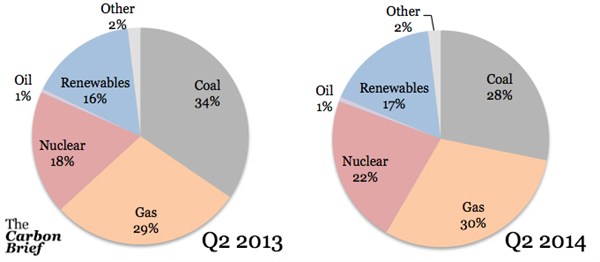Carbon Brief Staff
25.09.2014 | 10:45amThe UK’s demand for electricity is falling and generation is becoming less carbon intensive, new government statistics show.
The Department of Energy and Climate Change’s (DECC) quarterly energy statistics show gas partially replaced coal power between May and July this year. Low carbon energy sources such as wind, solar and nuclear generated almost five per cent more electricity than in the same three months last year, the data shows.
Coal returns to historic low
The share of electricity generated by coal-fired power stations fell to 28.2 per cent in the second quarter of 2014, compared to 34.5 per cent in the same quarter last year. This matches the historic low coal-fired electricity generation reached in 2009-10.
Since then, falling coal prices and impending plant closures due to EU legislation had seen a surge in coal use. The latest data suggests this was a temporary blip, as we predicted earlier this year.
There have been some media reports that David Cameron wants coal to be phased out entirely, but a well-placed source tells Carbon Brief there is no new policy to close plants down.
Instead, there is a government expectation that existing EU rules on air pollution and other factors will see all unabated UK coal plants close by 2030. DECC has previously called this a phase-out.
So what did we turn to instead of coal? Gas, nuclear and renewables all claimed a larger share of the generation.
Source: DECC quarterly energy statistics.
Renewables fall
Despite renewables’ overall share of generation increasing, the total amount of electricity generated by wind and solar farms actually fell by about 10 per cent in the second quarter of 2014, compared to the same period last year, as the chart below shows.

Source: DECC quarterly energy statistics. Graph by Carbon Brief.
As the UK ramps up its wind, solar, and hydro capacity, more renewable power is available to the grid. But renewables need the right weather conditions to work.
Wind power provided almost 20 per cent less electricity from May to July this year, compared to the same three months a year ago. That’s because wind speeds were much slower than this time last year, DECC says.
Solar power compensated for this shortfall, to an extent. Solar generation increased by 67 per cent compared to the same period last year, as more solar farms are now connected to the grid.
Hydro generation also increased by 16 per cent due to much heavier rainfalls, mainly during May, in the regions where the UK’s hydropower plants are.
Demand keeps falling
The main reason renewables’ share increased despite the amount of electricity they generated falling was a drop in overall demand. Electricity generation fell to its lowest level since 1998, falling 6.2 per cent compared to same three months in 2013.
Demand has defied expectations and a rising UK population to fall continually since the mid-2000s. This is down to a combination of energy efficiency measures and high electricity prices.
Despite the increase in low-carbon share, there is a long way to go before the UK is decarbonised. As these figures remind us, more than half of the UK’s electricity still comes from fossil fuels.
Update, 25/09. 12.30: The graphs were updated to fit with out house style.


